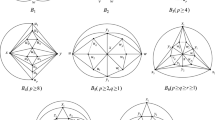Abstract
There are numerous means for measuring the closeness to planarity of a graph such as crossing number, splitting number, and a variety of thickness parameters. We focus on the classical concept of the thickness of a graph, and we add to earlier work in [4]. In particular, we offer new 9-critical thickness-two graphs on 17, 25, and 33 vertices, all of which provide counterexamples to a conjecture on independence ratio of Albertson; we investigate three classes of graphs, namely singly and doubly outerplanar graphs, and cloned planar graphs. We give a sharp upper bound for the largest chromatic number of the cloned planar graphs, and we give upper and lower bounds for the largest chromatic number of the former two classes.
Similar content being viewed by others
References
Appel, K., Haken, W.: Supplement to: “Every planar map is four colorable. I. Discharging” (Illinois J. Math. 21 (1977), no. 3, 429–490) by Appel and Haken; “II. Reducibility” (ibid. 21 (1977), no. 3, 491–567) by Appel, Haken and J. Koch. Illinois J. Math., 21(3), 1–251. (microfiche supplement) (1977)
Appel, K., Haken, W., Koch, J.: Every planar map is four colorable. Part II. Reducibility. Illinois J. Math., 21, 491–567 (1977)
Albertson, M.O.: A conjecture on the independence ratio of thickness-two graphs. (Personal communication).
Boutin, D.L., Gethner, E., Sulanke, T.: Thickness-two graphs. I. New nine-critical graphs, permuted layer graphs, and Catlin’s graphs. J. Graph Theory, 57(3), 198–214 (2008)
Battle, J., Harary, F., Kodama, Y.: Every planar graph with nine points has a nonplanar complement. Bull. Amer. Math. Soc., 68, 569–571 (1962)
Gardner, M.: Mathematical games. Sci. Amer., 242, 14–19 February 1980
Garey, M.R., Johnson, D.S.: Computers and Intractability; A Guide to the Theory of NP-Completeness. W. H. Freeman & Co., New York, NY, USA, (1990)
Garey, M.R., Johnson, D.S., Stockmeyer, L.: Some simplified NP-complete problems. In STOC ’74: Proceedings of the sixth annual ACM symposium on Theory of computing, pp. 47–63, ACM Press New York, NY, USA, 1974.
Guy, R.K., Nowakowski, R.J.: The outerthickness & outercoarseness of graphs. I. The complete graph & the n-cube. In: Topics in combinatorics and graph theory (Oberwolfach, 1990), pp. 297–310. Physica, Heidelberg (1990)
Guy, R.K., Nowakowski, R.J.: The outerthickness & outercoarseness of graphs. II. The complete bipartite graph. In: Contemporary methods in graph theory, pp. 313–322. Bibliographisches Inst., Mannheim (1990)
Hajós, G.: Über eine Konstruktion nicht n-färbbarer Graphen. Wiss. Z. Martin Luther Univ., 10, 116–117 (1961)
Hutchinson, J.P.: Coloring ordinary maps, maps of empires and maps of the moon. Math. Mag., 66(4), 211–226 (1993)
Jensen, T.R., Royle, G.F.: Hajós constructions of critical graphs. J. Graph Theory, 30(1), 37–50 (1999)
Kocay, W., Kreher, D.L.: Graphs, algorithms, and optimization. Discrete Mathematics and its Applications (Boca Raton). Chapman & Hall/CRC, Boca Raton, FL (2005)
Koester, G.: 4-critical 4-valent planar graphs constructed with crowns. Math. Scand., 67(1), 15–22 (1990)
Mansfield, A.: Determining the thickness of graphs is NP-hard. Math. Proc. Cambridge Philos. Soc., 93(1), 9–23 (1983)
McKay, B.D.: Groups and Graphs: software package for graphs, digraphs, graph embeddings, projective configurations, polyhedra, convex hulls, combinatorial designs, automorphism groups, and fractals. Website, 1997-2007. http://www.paddle.mb.ca/G&G/G&G.html/
Ringel, G.: Färbungsprobleme auf Flächen und Graphen, volume 2 of Mathematische Monographien. VEB Deutscher Verlag der Wissenschaften, Berlin (1959)
Robertson, N., Sanders, D.P., Seymour, P., Thomas, R.: A new proof of the four-colour theorem. Electron. Res. Announc. Amer. Math. Soc., 2(1), 17–25 (electronic) (1996)
Sulanke, T.: Decomposing graphs into triangulations using random diagonal flips. (in preparation)
Tutte, W.T.: The non-biplanar character of the complete 9-graph. Canad. Math. Bull., 6, 319–330 (1963)
West, D.B.: Introduction to graph theory. Prentice Hall Inc., Upper Saddle River, NJ, second edition (2001)
Wilson, R.: Four colors suffice. Princeton University Press, Princeton, NJ, 2002. How the map problem was solved
Wolfram, S.: Wolfram Research, Inc: Mathematica. Website, 1997-2007. http://www.wolfram.com
Author information
Authors and Affiliations
Corresponding author
Rights and permissions
About this article
Cite this article
Gethner, E., Sulanke, T. Thickness-Two Graphs Part Two: More New Nine-Critical Graphs, Independence Ratio, Cloned Planar Graphs, and Singly and Doubly Outerplanar Graphs. Graphs and Combinatorics 25, 197–217 (2009). https://doi.org/10.1007/s00373-008-0833-5
Received:
Accepted:
Published:
Issue Date:
DOI: https://doi.org/10.1007/s00373-008-0833-5




